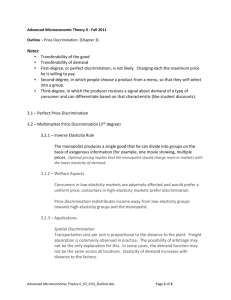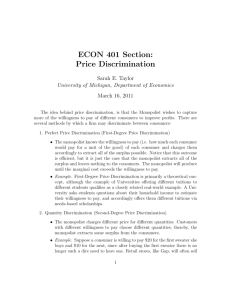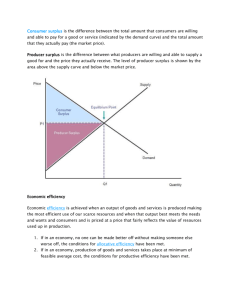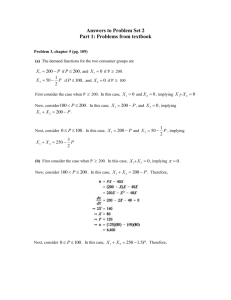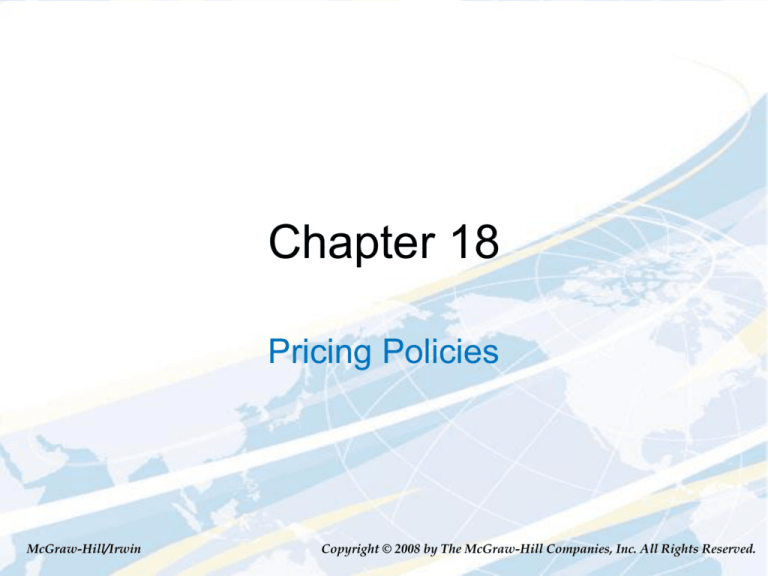
Chapter 18
Pricing Policies
McGraw-Hill/Irwin
Copyright © 2008 by The McGraw-Hill Companies, Inc. All Rights Reserved.
Main Topics
Price discrimination: pricing to extract
surplus
Perfect price discrimination
Price discrimination based on observable
customer characteristics
Price discrimination base on selfselection
18-2
Price Discrimination: Pricing to
Extract Surplus
Monopolist’s profit would be larger if he could solve two
problems
Consumers who buy some of the product receive some
consumer surplus
Monopolist could increase profit if he could charge them a
higher price
Consumers aren’t buying some units that they value
less than the monopoly price but more than marginal
cost
Monopolist could increase profit if he could charge these
buyers less for those units of the good
Monopolist might be able to do better by price
discriminating: charging different prices for different
units of the same good
18-3
Price Discrimination: Pricing to
Extract Surplus
To be able to price discriminate:
A firm must have some market power
If not, a price above marginal cost will result in zero sales
The good or service must be difficult to resell
Otherwise few sales will occur at the higher price
Firm must also be able to distinguish sales for which the
purchasers have a high willingness to pay from those they
have a low willingness to pay
A monopolist can perfectly price discriminate if he
knows perfectly the customer’s willingness to pay for
each unit he sells and can charge a different price for
each unit
18-4
Price Discrimination: Pricing to
Extract Surplus
Usually, a firm does not perfectly know a customer’s
willingness to pay
Two different ways to distinguish purchases for which
the customer has a high vs. a low willingness to pay
Price discrimination is based on observable customer
characteristics when a firm can distinguish
consumers with a high vs. low willingness to pay
Price discrimination is based on self-selection when
the firm offers a menu of alternatives
Designed so that customers will make choices based on their
willingness to pay
In quantity-dependent pricing, the price a consumer
pays for an additional unit depends on how many units
she has bought
18-5
Perfect Price Discrimination
Under perfect price discrimination, the firm knows
perfectly its customers’ willingness to pay
Can set the price for each individual consumer equal to
her willingness to pay
Marginal revenue curve coincides with the market
demand curve
Profit-maximizing sales quantity occurs where the
market demand curve crosses the marginal cost curve
Monopolist produces the same quantity as would occur
in a competitive industry
Each consumer consumes the same quantity as they would
under perfect competition
No deadweight loss
18-6
Figure 18.2: Perfect Price
Discrimination Sales Quantity
18-7
Two-Part Tariffs
Two-part tariffs are another quantity-dependent pricing
plan that allows a perfectly discriminating monopolist to
maximize profit
With a two-part tariff, consumers pay a fixed fee plus
a separate per-unit price for each unit they buy
Examples: amusement parks, rental car companies
Commonly used by monopolists and firms whose
market power falls short of monopoly
Advantage is simplicity: name just two prices
To maximize profit, set per-unit charge equal to
marginal cost
18-8
Figure 18.4: Profit with a
Two-Part Tariff
Per-unit charge equals
marginal cost
Fixed fee is the
consumer’s surplus at
that per-unit price
Maximizes aggregate
surplus
Leaves the consumer no
surplus
18-9
Sample Problem 1 (18.2):
If the ice cream company from figure 18.2 (page
669) sells to Juan (whose demand curve is
shown on page 524) using a two-part tariff with a
per-cone price on $1.50, what is the largest fixed
fee it can charge Juan and still persuade Juan to
make a purchase? How does its total revenue
from Juan under this two-part tariff compare to its
total revenue from Juan when it sells Juan four
cones, each priced at Juan’s willingness to pay
for it? What is its total profit from Juan?
Price Discrimination Based on
Observable Characteristics
Most often a firm’s ability to price discriminate is
imperfect
May be able to sort consumers into rough groups
based on observable characteristics
But know no more about their willingness to pay
Cannot engage in quantity-dependent pricing because cannot
track purchases
Example: small town movie theater with four consumer groups
(adults, seniors, students, kids)
To maximize profit consider each group’s demand
curve separately
Set price to maximize profit earned from that group
18-11
Price Discrimination Based on
Observable Characteristics
Set different prices whenever the groups have different
elasticities of demand
Charge a higher price to groups with less elastic
demand
Generally the group that will face the higher price is the
one with the less elastic demand at the profitmaximizing no-discrimination price
Starting at that price, monopolist will:
Raise the price of the less elastic group
Lower the price of the more elastic group
Can find optimal prices and quantities for each group
using algebra
18-12
Figure 18.5:Profit-Maximizing
Price to Two Groups
18-13
Sample Problem 2 (18.4)
Suppose moviegoer’s demand functions are
QS = 800 – 100P and QA = 1600 – 100P for
students and other adults respectively.
Marginal cost is $3 per ticket. What prices
will the monopolist set when she can
discriminate and when she cannot? How
will discrimination affect her profit?
Welfare Effects of Imperfect
Price Discrimination
Profit is at least as large with discrimination as without
Can always charge every group the same price, won’t charge
different prices unless it benefits the firm
Price discrimination affects different groups of consumers
differently
Worse off it my price rises as a result of discrimination, better off if it
falls
Two main effects on consumer and aggregate surplus:
Different consumers pay different prices, inefficient because a
consumer who faces a low price and decides to buy may have a
lower willingness to pay than a consumer who faces a high price and
decides not to buy
May encourage the monopolist to sell more, increase both consumer
and aggregate surplus
Opposing effects can combine to either raise or lower consumer
and aggregate surplus
18-15
Welfare Effects of Imperfect
Price Discrimination
In Figure 18.7, total consumer surplus is
smaller with discrimination
The gain to college students is smaller than the loss
to other adults
Aggregate surplus is also smaller with
discrimination
Gain in profit ($800) is smaller than the loss in
consumer surplus ($1,200)
The number of tickets sold is the same
But inefficiently distributed with discrimination
18-16
Figure 18.7: Welfare Effects of
Price Discrimination
18-17
Sample Problem 3 (18.8)
What is the effect of discrimination on
consumer and aggregate surplus in
exercise 18.4?
Price Discrimination and
Market Power
In a competitive market, firms can’t price
discriminate
Price discrimination is a sign of a market that is not
perfectly competitive
Can be difficult to determine whether price
discrimination exists in a market
Different prices may reflect cost differences
Market does not have to be very far from
perfectly competitive to exhibit discrimination
Oligopolists may price discriminate more than
monopolists
18-19
Price Discrimination Based on
Self-Selection
Often firms cannot distinguish between groups
of consumers based on observable
characteristics
Price discrimination may still be possible
Offer a menu of alternatives
If properly designed, customers with different
willingness to pay will choose different alternatives
A common practice
Examples: supermarket discounts for shoppers who
clip coupons, wireless phone companies with
multiple calling plans
18-20
Quantity-Dependent Pricing and
Self-Selection
Recall that a perfectly discriminating monopolist
maximizes profit with a two-part tariff
This level of profit is not achievable when consumers’
characteristics are not directly observable
If given the choice between two plans with the same
per-minute price, all consumers will opt for the lowdemand (low fixed fee) plan
Consumers will not self-select based on willingness to pay
The monopolist can often do better by raising the perunit charge above its marginal cost
Can do even better by offering a menu of different twopart tariffs
18-21
Figure 18.9: Two-Part Tariff with
Two Types of Consumers
18-22
Clearvoice Wireless Example
Clearvoice is a wireless telephone monopolist in a rural
area
Two types of consumers, high-demand and lowdemand
Distinct monthly demand curves for wireless minutes for each
group
Clearvoice’s marginal cost is 10 cents
If could observe consumer characteristics, would offer
two-part tariff with 10-cent per-minute price
Fixed fee for low-demand customers: $8
Fixed fee for high-demand customers: $40.50
18-23
Profit-Maximizing Two-Part Tariff
Suppose Clearvoice wants to offer a single two-part
tariff
Per-minute price of 10 cents and monthly fee of $40.50
High-demand customers accept
Low-demand customers reject
Per-minute price of 10 cents and monthly fee of $8
All consumer accept
Which plan is better?
If there are a large number of low-demand customers, $8
monthly fee is better
May be even more profitable to raise per-minute fee
above marginal cost
18-24
Profit-Maximizing Two-Part Tariff
If the monopolist plans on selling to both types of
consumer it is always profitable to raise the per-unit
price at least a little above marginal cost
Regardless of the types’ relative proportions
Would like to extract some of high-demand consumers’
surplus without changing surplus of low-demand
consumer (already zero)
Raise per-unit price to get more surplus from high-demand
consumers
Adjust fixed fee so low-demand consumers’ surplus is
unchanged
The smaller the faction of low-demand consumer, the
more worthwhile it is to raise the per-unit price
Deadweight loss from low-demand consumers increases
18-25
Figure 18.10: Benefits of Raising
the Per-Minute Charge
18-26
Using Menus to Increase Profit
Can do even better by offering a menu of twopart tariffs, each designed to attract a specific
type of consumer
Can eliminate some deadweight loss by introducing
a second tariff plan
Extract more surplus from high-demand consumers
by making the low-demand plan less attractive to
high-demand customers
18-27
Eliminating Deadweight Loss of
High-Demand Consumers
Suppose Clearvoice offers a pair of two-part tariffs
One designed for low-demand consumers:
Per-minute price of 20 cents, fixed fee of $4.50
Second option intended to attract high-demand
customers:
Per-minute price of 10 cents, equal to Clearvoice’s marginal
cost
Fixed fee should be set as high as possible without causing
high-demand consumer to choose the other plan
With menu of plans:
Firm profits are higher from high-demand consumers
Profits from low-demand consumers are the same
Deadweight loss from high-demand consumers is eliminated
and extracted as surplus
18-28
Figure 18.11: Menu of
Two-Part Tariffs
18-29
Making the Low-Demand Plan
Less Attractive
Can increase profit even more by making the lowdemand plan less attractive to high-demand
consumers
That plan determines the fixed fee the firm can charge a highdemand consumer
It is the level that makes the high-demand consumer indifferent
between the two plans
Limit the number of minutes a consumer can purchase
in the 20-cent-per-minute plan
Set the limit equal to the number low-demand consumers want
Will have no effect on value a low-demand consumer derives
Make the plan less attractive to high-demand customers
Will increase the fixed fee Clearvoice can charge high-demand
consumers for the 10-cent-per-minute plan
18-30
Figure 18.12: Capping Minutes
18-31
Menu of Two-Part Tariffs
A firm can often profit by offering a menu of
choices
Designed for different types of consumers
To maximize its profits, firm should try to make
each plan attractive to one group only
And unattractive to other consumer groups
Firm benefits from setting the per-unit price in
the plan intended for consumers with the
highest willingness to pay equal to the marginal
cost
Eliminates deadweight loss for those consumers
18-32
Sample Problem 4 (18.12):
Air Shangrila sells to both tourist and business
travelers on its single route. Tourists always stay
over on Saturday nights, while business travelers
never do. The weekly demand function of tourists
is QT = 6,000 – 10P, and the weekly demand
function of business travelers is QB = 1,000 – P. If
the marginal cost of a ticket is $200, what prices
should Air Shangrila set for its tourist and
business tickets? If the government passes a law
that says all tickets must cost the same, what
price will Air Shangrila set?

